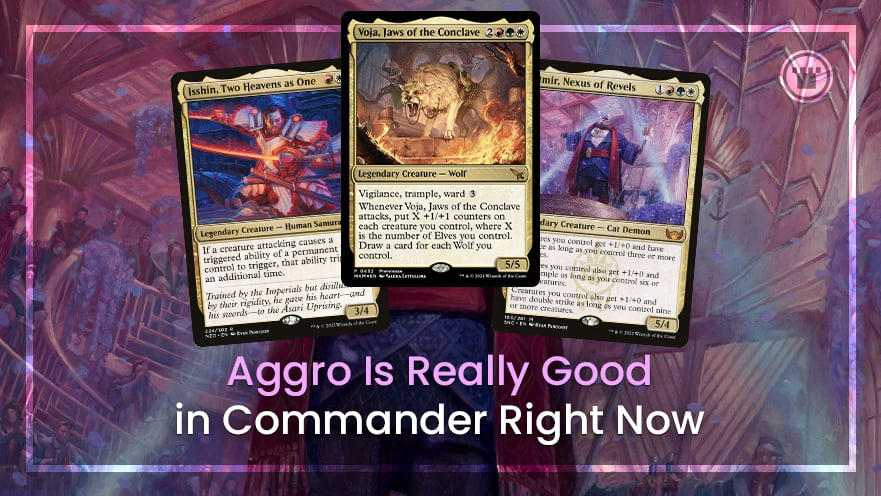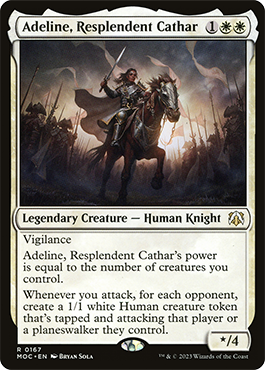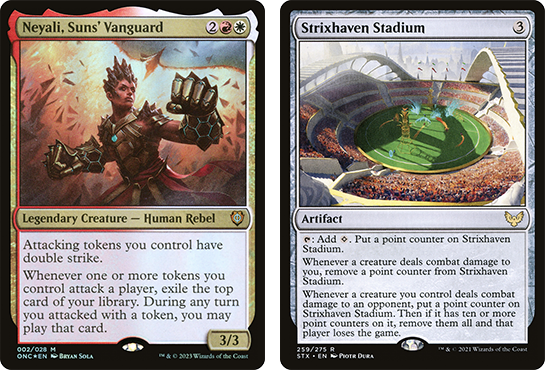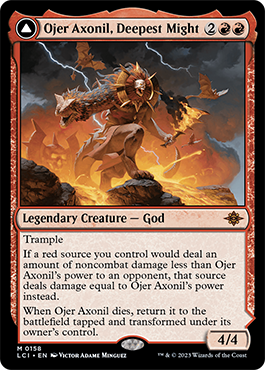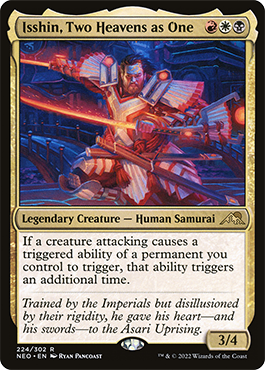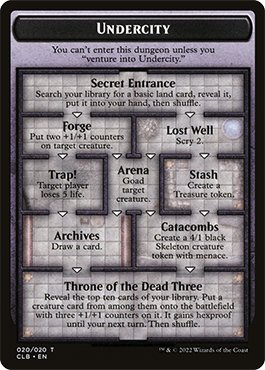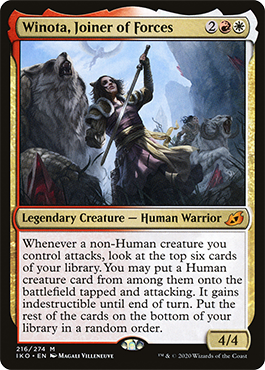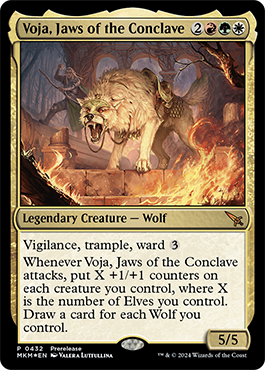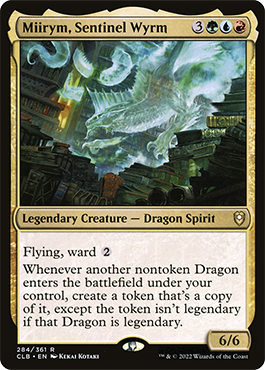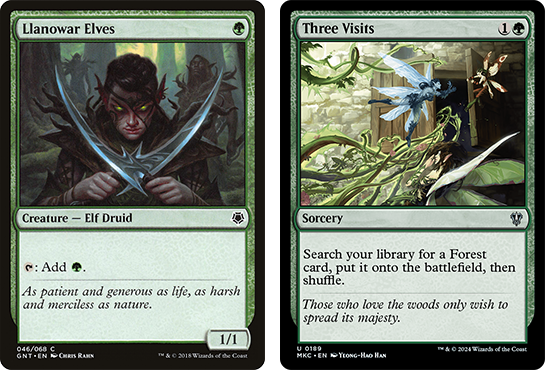Aggro is enjoying something of a renaissance in Commander right now. Thanks to numerous changes to how people build and play, and a myriad of new pushed cards, it’s never been a better time to turn creatures sideways. Kristen digs in to find out why – and whether the new Voja is a little too pushed.

I’ve always been one to turn creatures sideways, even if I knew that it was a strategy with a low ceiling when I started playing Commander. There were constant boardwipes, fogs, plenty of blocking, and by the time you could get a good board, someone would either Cyclonic Rift or combo off.
In times past, that meant I put redundant combos into my aggro decks, and damage-can’t-be-prevented effects. It meant I pursued Voltron more than go-wide, and it meant playing a lot of green. I don’t think that’s the case anymore, though. Aggro is in a really nice spot.
AGGRO IS REALLY GOOD IN COMMANDER
In previous set reviews, I’ve been pretty cold on the likes of Giada as a Commander. I viewed her as still putting too many eggs into one basket, a Commander that was still prone to blowouts from boardwipes. I favoured Shalai for the protection and access to green. Fast forward a couple of years, and I think I’m ready to accept that Giada has a place at the table.
What’s more, I think cards like Serra Avenger and Youthful Valkyrie are actually playable, and if I were to run Giada now, I would include these cheap angels. Why?
BLASPHEMOUS ACT
Well, it’s because of a perfect storm. At the center of it, is that players on average play fewer wraths, seeing them as anti-social.
I’ve waxed lyrical on this issue before, but suffice to say, when players look to content for a guide on how to build and play, they don’t do so with a critical eye. They don’t examine that these lists and shows exist in a space where time is limited, and resets are “dead air”. They’re entertainment.

For a while now, I’ve been of a similar opinion to Serge here; don’t wrath in the late game unless you are capable of turning things around and have a game plan. Where we diverge is on what’s considered the right time to sandbag board wipes. Generally for me, it’s past the 80-90 minute mark. I’m not going to tell anyone how to have fun here, and I respect Serge a lot – and in his playgroup, perhaps they enjoy tight gameplay that gets them through lots of turns quickly – but 45 minutes seems woefully inadequate.
Commander decks in 2024 can take multiple 10 to 15 minute turns, taking game actions that don’t necessarily progress the game, and this can happen earlier and earlier. If we take this into account, then 45 minutes could pass by in the blink of an eye. Think about being sat across from a deck using Food and Clues, tapping some for mana, cracking some Treasure. Think about token decks that require drawing infinitokens and delineating +1/+1 counters. On average, there will be at least one deck in a pod doing this kind of thing, with no Superfriends decision-point-durdle necessary.
Again, I won’t tell people how to have fun, and please don’t go dunk on Serge (or anyone else that shares this view) just because I’m using his tweet as a conversation starter – but you also have to approach this viewpoint with that same critical eye. What’s good for the goose might not be good for the gander.
When you combine this approach to gameplay with shorter game lengths, and the fact that most wraths involve taking the turn off – a huge tempo loss – players are reluctant to drop a wrath. They’re reluctant to play them. Decks can turn the corner easier than ever, and resetting the board to hand the game to another player feels awful. Doubly so if you have peer pressure telling you not to play to your outs because of an arbitrary time milestone.
What’s wild is that there are now so many wraths to choose from, that it’s easy to fill your deck with cheap and/or asymmetrical wraths. And playing them? Well, it can really unlock a board stalemate, slow down a snowballing archenemy… or halt the aggro decks.
MAKING AGGRO RELEVANT AGAIN
Reluctancy to play wraths isn’t the only catalyst for Aggro being great right now. Another is R&D pushing combat. So many cards are an attack or on-damage trigger nowadays that you’re under a constant barrage of attacks. It’s why I’m big on vigilance and lifelink, and why that dummy thicc 2/4 body is so relevant.
Goad has impact, too. Goad pushes a lot of damage through, and can quickly spell doom. Taunt from the Rampart and Bothersome Quasit are two very potent effects, and R&D has made sure to offer a lot of Goad in recent years to help “unstick” board stalls. In practice, this means that you don’t just have to worry about whether the aggro player wants to attack you – they might be forced to.
TOKENS AND BURN CAN WIN QUICKER
Tokens as a strategy has enjoyed a similar push. Cards like Adeline and Anim Pakal churn out bodies like nobody’s business, and there are card draw engines that work incredibly with tokens entering play.
Neyali as a Commander cements Boros tokens as a force to be reckoned with, but not only that, she brings down the curve and shows that card quality low on the curve has never been higher. It’s about building a synergy, “building a 7-drop”, rather than playing one. Impulse draw? Who cares, you have redundancy now. There’s Anointed Procession and Mondrak and Ojer Taq.
Speaking of Ixalan Gods, Ojer Axonil is the premier burn deck right now. Who cares if all your ping effects are low investment and low impact when your Commander can convert them into serious damage? Buff Ojer Axonil, or just stack up a board full of things like Impact Tremors, Cavalcade of Calamity and Purphoros God of the Forge and watch life totals melt.
Warleader’s Call encapsulates how far Aggro has come; it’s just three mana for an anthem and an Impact Tremors. The card is absurdly good, and adds a lot of damage to the board.
What’s more, burn spells have gotten better too. While Prisoner’s Dilemma might read as a fun politics card, it’s actually seriously efficient burn, and when combined with a damage double or tripler? It can end games very quickly.
Tokens and Burn being able to win quicker, in essence, removes some of the stranglehold that midrange Green decks and control/combo decks have on the format. The most exciting pods are pods that involve at least one of each of these ancient archetypes, and if anything, them being boosted in viability should help players feel more comfortable playing Control.
AGGRO COMMANDERS THAT DOMINATE GAMES
I mentioned Giada briefly before, but in essence, what makes her so good in 2024 is that those Angels coming into play with multiple +1/+1 counters on are likely to stay in play, particularly if they’re unassuming and/or cheap bodies like Youthful Valkyrie and Angel of Finality. People will still save removal for Avacyn and Lyra, right? Speaking of which, Giada’s access to lifegain synergies is a big part of what makes that deck so good right now.
With fewer wraths being played, it’s snowball aggro Commanders that really take the glory. Otharri is one I played against recently, and without disenchants for the anthems and without a wrath, the deck managed to get life totals moving quicker than me when I see a spider emerge from the crack in the sofa.
We can’t mention Snowball Commanders without mentioning Isshin. While he can be slowed somewhat by removing him, the fact that the rest of the deck exists to turn sideways for value means that even just getting one portion of triggers instead of an extra large portion can still have the deck start to gain enough momentum that it’s hard to stop.
Leveraging Dungeons and absurd triggers like Etali, Primal Storm and even less broken cards like Tectonic Giant can create plenty of value and dish out plenty of damage.
THE NATURAL BALANCE TO AGGRO
There’s a huge fallacy that playing too much removal makes the game take a lot longer. While that may be the case some of the time, a lot of the rest of the time, games will end shortly after a wrath as the board is “unlocked”. Also, with a tight playgroup who take turns efficiently, and know their decks? You can finish an 8-10 turn game with a couple sweepers in just over an hour.
The modern aggro deck, uncontested, can snowball a game at a rate that is a lot closer to cEDH Winota than many care to admit. This means that while aggro decks are winning sooner than midrange and control (which is objectively correct, even when decks are as close to parity as possible in regards to power), they are doing so much more often because their boards aren’t being dismantled enough.
How is aggro usually balanced? Well, it’s the lack of late game punch. Eventually it can’t get through bigger blockers, and it loses a lot of board presence to sweepers.
The thing is, with combos and tutors being uninteresting to many Casual players, the decks that can naturally answer an Aggro deck are starting to struggle. They’re starting to struggle because curves are lower; because you get way more card for your mana; because cards are increasingly efficient; and because they’re refusing to play board wipes.
VOJA, JAWS OF THE CONCLAVE: A BROKEN MAGIC CARD
Okay, now it’s time to really drop a hot take. I think Voja is broken, and I think it’s a watershed moment for power creep in Commander.
Voja somehow manages to nullify every weakness of a typical aggro deck and turns them all into strengths. It does this under a veneer of “casualness”; putting Wolves and Elves together for the first time, two popular casual archetypes that previously only had Tolsimir as a Commander. To truly see how strong Voja is, let’s look at it compared to other recent Commanders that draw similar ire.
VOJA VS MIIRYM
First up, everyone’s favorite Dragon copier, Miirym. Miirym is a hella fun deck to play, and it’s also extremely strong with the right draws. Note that last part: with the right draws. The construction of the average Miirym deck (if we take all-clone lists out of the equation) is comprised of:
- A lot of ramp, because getting Miirym out is essential, as is recasting it when it inevitably gets removed. It’s similar to Kaalia of old in this respect.
- Plenty of draw to find dragons and interaction.
- A bunch of dragons, most costing upwards of four mana to cast.
In practice, this can make Miirym a “feast or famine” kind of deck. If you draw the cards in the right order, you win, easily. If not, you sit and draw ramp, and more ramp, and struggle to draw enough Dragons. Playing Miirym without the backup in hand is taking a turn off, and wasting it; this means quite often it’s correct to not cast Miirym on six mana because you don’t want to pay eight mana again next turn.
With Voja, this isn’t a problem. Your Ward is increased to Ward 3, which is even harder to pay for. You have access to Deflecting Swat/Bolt Bend, but also to Flawless Manuver. While you lose Fierce Guardianship, you gain Teferi’s Protection, Galadriel’s Dismissal, et al.
Voja also ramps by casting creatures, the same exact creatures you’d want in play anyways to win with your deck. You don’t need signets and Three Visits when you can drop mana dorks you’ll later attack with.
Voja also draws cards, which means playing him with a medium hand is still a good move, because one of your outs is to draw out of it. Miirym doesn’t do this.
VOJA VS JETMIR
Another deck in the same colors, that utilizes the same strategy of deploying mana dorks, is Jetmir. Jetmir asks you to go wide, much like Voja. Your payoff, like Voja, is a bunch of extra damage. Vigilance, Trample, and Double Strike do indeed win games.
What makes Voja and Jetmir different? Well, while Jetmir has the advantage of giving the team trample, they won’t get as large as the dorks in a Voja deck. Voja will find it comparatively easier to grant an overrun than Jetmir will find it to add more damage to the board.
There’s also one key part of the equation: removing Jetmir. If you simply remove Jetmir, the dorks turn back into dorks. The same isn’t true for Voja.
First off, to even remove Voja in the first place, it has Ward {3}. That’s six mana for a Beast Within. That’s five mana for a Despark. And if you do remove it? Well, the creatures in play keep all of the +1/+1 counters, so while they might have started off as one mana 1/1s, they’re now probably 6/6s. All the Voja player needs to do to convert that damage is turn it sideways or drop a card like Garruk’s Uprising to grant Trample.
VOJA IS VERY PUSHED
Without getting on my soapbox too much here, giving Voja Ward {3} when it’s already in Naya colors with the best access to Heroic Intervention and the rest, is just too much. Removing Voja is kinda like removing Henzie, except arguably less impactful if they’ve already gotten to swing, buff the team, and reload the hand.
Recasting it is easy thanks to Voja’s natural synergy with cards like Marwyn the Nurturer. You can fill your hand back up too, being in green and having a Commander that draws cards.
The issue with Voja is that it enters the Commander meta at a time when people are playing fewer wraths than ever. It enters at a time when Roaming Throne can give it Ward {3} twice. It enters at a time when life totals drop consistently, meaning just one trigger off of Voja after curving out can end the game.
It can also just Commander damage people out of the game, given it grows itself and has Trample. Is there anything this card can’t do?!
What’s more, even though Voja will elicit the same groans and contempt as Commanders like Korvold, Prossh, or new Atraxa, it’s ostensibly fair, because it’s a creatures deck, like Yuriko – another design mistake.
I call this a watershed card because if this is the power level Wizards are aiming at for aggro, and people are still set on not playing sweepers, hatebears, or stax-lite, then yeah, this has quickly turned toward a turn 6-7 format. You can’t dial that back.
END STEP
Aggro is in a great place right now, and I love to play it. Choosing who to attack and why remains a core strategic element of multiplayer magic, and having Aggro decks feel on par with other archetypes is really healthy for the format. That said, a lot of what has made aggro better is pushed cards being pumped out year on year. Wizards needs to take the foot off the pedal a bit – we don’t need cards like Voja, that ask no deckbuilding concessions.
While Ward started out as a neat way to make Hexproof less backbreaking, it’s also edged out other older expensive Commanders who “feel” like they should have Ward if they were printed today. The other crux point is multiple instances of Ward. Once you start stacking them up, it becomes better than Hexproof, which can actually be removed by a number of lands and spells (and Shadowspear).
Soon, we’ll reach a point where decks like Selesnya Humans have so many additional layers of Ward that they’ll be all but impenetrable.
You know what solves that?
A board wipe.

Kristen is Card Kingdom’s Head Writer, and member of the Commander Advisory Group. Formerly a competitive Pokémon TCG grinder, she has been playing Magic since Shadows Over Innistrad, which in her opinion, was a great set to start with. When she’s not taking names with Equipment and Aggro strategies in Commander, she loves to play any form of Limited.

